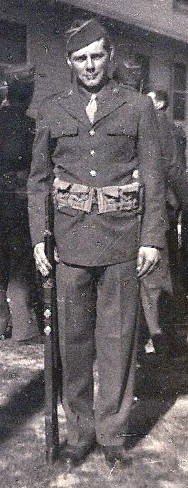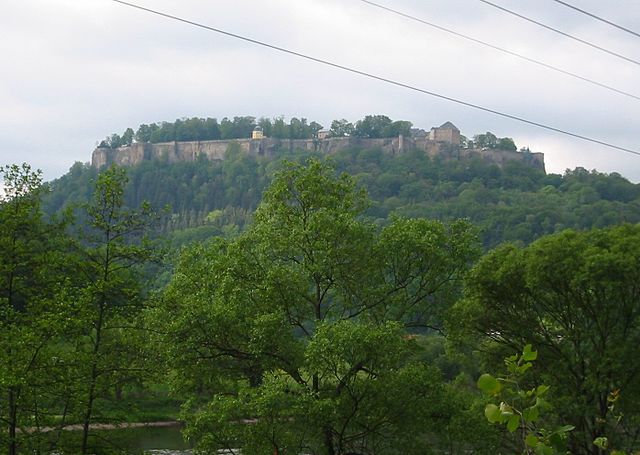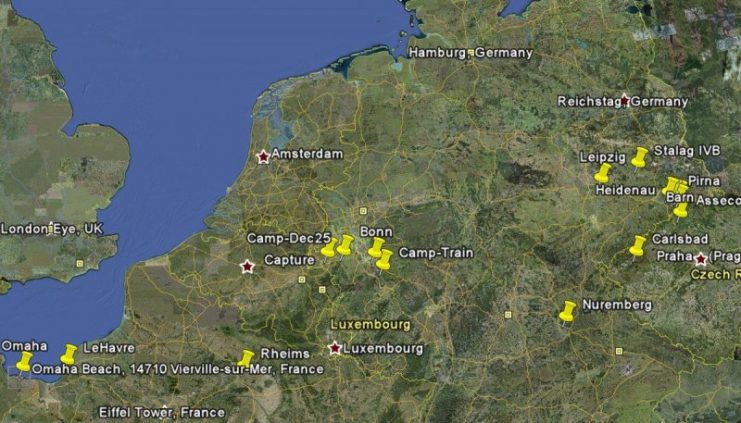Slave labor for the Reich
Because he wasn’t an officer or a non-com, he and other privates were classified for “komando” – labor camp – assignments. They disappeared from Red Cross accounting at this time, they went off the radar: they became slave laborers. There was no Red Cross food, just turnips. James was included in a group of 50 men who were sent by train to a labor “barrack building” (Lager) located in the city of Heidenau, a southern suburb of Dresden on the west bank of the Elbe River. The arrival date was approximately January 22, 1945. He was included in a work gang of 12 men assigned to excavate a deep ditch for a large drain line from a “factory-like” building nearing completion about 3 miles from their building. Their already meager rations were cut in half; they realized the German NCO in charge was selling the other half of their meagre food ration on the Black Market, but there was nothing they could do about it. A soldier would march them to the job site at daylight and would come and bring them back at dusk.
They continued on this job until March 13th when Dresden was bombed by B-17 bombers. The city had been bombed by the Brits the night before, but James noted that they didn’t do nearly the damage of the huge B-17’s. Initially he said they watched with interest as huge amounts of material were blasted into the sky… but then noticed that the destruction was approaching them. At the last moment they took cover, and a large bomb fell into the garden of a house approximately 100 feet (30 m) from where they were, across the street watching the progress of the devastation taking place. They were then taken in groups of about 10 men on a truck to various locations on the outskirts of the city to repair holes in the highways caused by the bombs. This went on for approximately four days.
At this time the remnants of the original 50 men were moved south 9 miles (15 km) to the town of Pirna where they were made to unload river barges and reload material onto trucks. James said things went from bad to worse for them, that it was a very grim time. At one point he weighed himself on an industrial scale: 110 lbs (50 kg) counting his uniform, winter field jacket, and boots. James is nearly six feet tall (180 cm) and normally weighed 185 lbs (85 kg). At least 10 men of the original 50 in the komando did not survive the hard labor and starvation. The group worked in Pirna for approximately 30 days. Near the end, they could hear the Russian Army artillery barrages getting closer by the day.

On or about April 17, 1945, they were marched under guard east across the Elbe River approximately 30 miles (50 km) to a farm in the Black Forest area. On the way to the farm he saw a great fortress on a mountain to their left (east) that they were told held high-ranking Allied officers. This was likely Königstein Castle (POW camp Oflag IVB; Oflag derives from Ofiziers Lager). The huge structure dates from the 1200’s, initially built by King Wenceslas to demarcate a boundary between two rival subordinate kingdoms. It was used to hold captured French, American, and British generals in great luxury during both World Wars. Historical records indicate that there was a huge difference in German treatment for officers vs. regular soldiers. The farm James arrived at had a large barn where they joined about 160 other Americans and English POWs.
With nowhere else to go, they stayed and worked for local farmers in exchange for food. Around 7 pm on May 7, while still at the farm, word was sent down from the farmhouse that the war was over. The next day, two of the former guards who had escorted them to the farm said they would lead the POWs to the American lines located in the town of Pilsen (now in the Czech Republic, but at that time still part of the Sudetenland annexed by Germany in 1938). They started walking immediately in a “very unorganized column” behind the German soldiers, who had discarded their arms. By noon on the 2nd day the German soldiers vanished as Russian forces approached, but they continued on the same highway in a southwesterly direction. On the 3rd day, as they approached the town of Ausig (now Asseco in the Czech Republic), about noon, there appeared a column of Russian trucks loaded with troops led by officers in a command car, who moved into the nearby town to begin their occupation. James said the Russian soldiers were from the Caucasus, were notably short – and by virtue of being there, these guys were very, very tough. The Russians befriended the American POWs and fed them.
Word was passed up the road by mouth that all of the POWs would have to get off the road, so they moved into the town. James estimated there were now about 300 – 400 POWs gathered. There was a public square in the center of Ausig where the POWs would gather. On the second day a Russian officer advised them that a train would be made up to move them to the American-occupied area the next day. This promise was given daily for approximately four days. Each morning they would get up and go to the square where they would normally “hang out” and always hope this day a train would come.

On one morning when James and his buddy George Hazelton arrived at the square, there was no one in sight: they started running to the train depot, which was about 3 city blocks away. When they arrived, there was the train – but it was already fully loaded. Every one of the 10 railway cars was packed with men, and the only space left was on top of the cars. The only alternative to staying was to ride on top of the railway car for the journey. The train left the station very slowly about 2 pm that afternoon and never exceeded 15 mph (25 kph). It traveled all afternoon, all night, and all the next day into the next night, stopping periodically. This was probably the Decin – Ausig/Asseco – Karlsbad/Karlovy rail line still in use today. At about 4 am the following morning (it was still dark), they arrived at Karlsbad (now Karlovy, Czech Republic) where the train stopped. Some GIs came down to the train and directed everyone to an area about 6 blocks up the hill. These were the first American GI’s other than their fellow POWs that they had encountered in six months, and it was immeasurably uplifting to see them.
James’ buddy Hazelwood found an unused roll of film on a road, and about two weeks later found a sergeant with a German camera who said it would fit, and borrowed the camera to take some photos. Later he sent some to James, which he still has. Two of these photos are at the top of this document. They were wearing the same clothes they had on when captured at the Battle of the Bulge, and he said they looked pretty ratty. In the photos they look clean-shaven, but had not shaved in six months – no hair or fingernails grew, so deep was the starvation they suffered. James was exultant as this photo was taken; they were rail-thin and lice-infested, “But we had FOOD!” From Karlsbad they were trucked to Nürnburg. Their clothes were thrown into a big pile here and burned (“lice and all – and boy, those lice could really eat on you,” commented James). They took their first shower here, and were given bars of strong lye-based soap that burned their skin, but he said he felt like a new man. They were issued clean clothes and felt they were GI’s again; they were no longer the “lousy louts”. They were flown from Nürnburg via C-47 transport planes to Rheims, France, where they were first checked over in a large field hospital, then moved from there to camp “Lucky Strike” at the French port of Le Havre, where they got their first real hot meal: STEAK. They spent a week there, then were trucked to the port, where they boarded a Navy troop transport for their return voyage to New York City. James reached New York Harbor on 11 June, and arrived home in Somerset, KY, on 18 June.
They were allowed three months home-leave, then he reported to Camp Oglethorpe in Chattanooga, TN, where he was promoted to Corporal to allow him to serve as a mail clerk until his discharge in January 1946. Though asked repeatedly to re-enlist, he resolutely declined.
After James returned stateside, he discovered that the Army had lost all his records. He had his dog-tags (both American and German), but had to submit telegrams sent to his wife to prove to the VA that he had actually served. He had fallen through the cracks. Because he was a POW when what was left of his battalion had received their Citations for fighting in the Bulge campaign, he was lost and forgotten. 57 years later the Army belatedly awarded the Bronze Star to an uncomplaining James Wynn (this was formally awarded in 2001 – the news clipping is displayed proudly on the family website).
By some miracle, James was able to keep a small soft-side notebook and pencil inside his long-johns during the entire ordeal; it was never discovered by his guards. This diary, which has details and dates, was transcribed by Alice Wynn and can be seen here Diary.
The Dresden Bombing, 13-15 March, 1945
“We were being kept as POWs in a Lager in Heidenau on the southeast side of Dresden, digging a big ditch 25 feet deep by 30 feet wide (8 m x 10 m), from a large factory down towards the Elbe River. The Brits had bombed the city the night before, but that was nothing like what the B-17’s would do. About 10am we heard sirens, and looking west we saw the planes coming. This work area was alongside a two-lane street, cobblestone-covered with gravel, and on one side were houses. This road went about 3/4ths of a mile (~ kilometer) down to the Elbe River, and the ditch we were digging paralleled the road. In an open field on one side, there were 40 to 50 telephone poles stacked on what looked like low concrete walls. Our guards crawled under these poles and gestured for us to get into the “field office”, which was basically a large wagon with windows from which they had watched us work.

To the north we could see buildings being blown up – huge explosions and debris blasting up into the sky – and it was coming towards us. It was exciting, but we could see that real serious destruction was heading our way, and scrambled to obey the guards’ instructions to get onto the floor of the field office wagon. The bombing stopped only about 400 yards/meters away; it seemed like the B-17s were clearing their 3-bomb “racks” and a 500-pounder (225 kg bomb) hit only 100 feet (30 m) away. Fortunately, it hit a garden, where it dug an immense hole. The next day the guards took a work detail of 14 including James to the perimeter of Dresden to fill bomb craters in the roads. It was a good thing they didn’t take them into the city itself, or the people would have killed them. There was a main east-west highway that passed by near their building; it was about 40 feet (12 m) wide. For a day and a half, he saw people streaming west on that road, filling it as they walked 10 abreast, “like the living dead, with faces so blackened by soot that they appeared to be West Virginia coal miners coming out of the mine.”
George Wynn’s search for his younger brother; World War II ends
From the time of James’ initial capture, George searched for information about his brother. Nothing was known – he was MIA. This went on for many months, and George said he had no idea how his mother, Anna Wynn, and James’ wife Alice dealt with this. He said he used all his poker and banking connections to talk with some “intelligence people”, and finally located people from James’ 38th regiment. These people painted a grim picture, and said that no one had survived from the 2nd battalion – all had been killed. It wasn’t until April 20 that a Red Cross letter from James, sent from Stalag IVB, got to his mother Anna Wynn, and his wife, Alice, letting them know that he had at least survived the Bulge.
George never was able to connect with James; they each separately returned to the US. George was on a Liberty ship from England August 4th until August 12th or 13th when they heard over the ship’s radio (conveyed by a drunken ship’s captain) first that a single bomb destroyed an entire Japanese city (Hiroshima, August 6th), then three days later another single bomb had destroyed yet another entire city (Nagasaki, August 9th), and the men on the ship couldn’t get over this: a single bomb! A few days later they heard that the war in the Pacific was over. He told me years later that he had forgotten about his birthday (August 8th) until August 12th or so, when he realized that he was not going to be shipped across the continent to invade the Japanese home islands, where a million casualties were expected. All the men realized that instead they were going home, and would be able to have families. He said that this was the best birthday present he had ever received. I was born in early June 1946 – the very lead wave of the Baby Boom. – Jeff Wynn
On the home front – by Alice Wynn
At home, after James embarked for Europe on July 15th, Alice returned to Somerset, KY, to live with James’ mother Anna Wynn in her apartment. Alice began working at a local retail ice cream store. When James’ letters stopped after late November, Alice would meet the mailman every day, hoping for some word from James.
On January 19th, Alice received a telegram from the War Department notifying her that James was “Missing in Action” since December 18th. For five months beginning with no word from James, ending with the telegram from the War Department that James was back under Army control, was a stressful time of hope, fear, and no word from anyone. As days and weeks went by, each day became a day of prayer, a deeper realization of helplessness and a greater dependence on the love and protection of God by Alice and James’ mother Anna.
When the mailman became aware of the situation, he promised to check his mail each morning and if a letter arrived, he would call Alice immediately. On April 20th, the mailman called Alice: there was a letter. She immediately ran all the way to the post office for the Red Cross letter James had written while at Stalag IVB on January 10th. This was the only information she received until a telegram from the War Department dated May 28, that James had returned to military control. James reached New York harbor on June 11, and arrived home on June 18th, 1945.
Looking back – by James L. Wynn
I accepted the Lord Jesus Christ as my personal Savior and committed my life to Him and to following Him as a born-again Christian believer the first week of January, 1944. I had no idea at that time how soon I would experience what a wonderful and perfect helper the Holy Spirit would be. He helped me maintain a complete trust in His presence and His watchful care and He gave me a special inner peace that I enjoyed throughout all the experiences mentioned in this very memorable episode of a long and exciting life. At this time in my life; through experiences, considering past events and daily seeking the will of God, I have come to this conclusion: If you seek the will of God and His direction in every decision you make, it will lead you to a true joy in His Presence forever.
James Lincoln Wynn just celebrated his 95th birthday; He has two great-great-grandsons and he lives in Greenville, SC.
